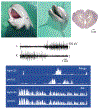Clues to the functions of mammalian sleep
- PMID: 16251951
- PMCID: PMC8760626
- DOI: 10.1038/nature04285
Clues to the functions of mammalian sleep
Abstract
The functions of mammalian sleep remain unclear. Most theories suggest a role for non-rapid eye movement (NREM) sleep in energy conservation and in nervous system recuperation. Theories of REM sleep have suggested a role for this state in periodic brain activation during sleep, in localized recuperative processes and in emotional regulation. Across mammals, the amount and nature of sleep are correlated with age, body size and ecological variables, such as whether the animals live in a terrestrial or an aquatic environment, their diet and the safety of their sleeping site. Sleep may be an efficient time for the completion of a number of functions, but variations in sleep expression indicate that these functions may differ across species.
Conflict of interest statement
The author declares no competing interests.
Figures




References
-
- Dinges DF, Rogers NL & Baynard MD in Principles and Practice of Sleep Medicine Vol. 4 (eds Kryger MH, Roth T & Dement WC) 67–76 (Elsevier Saunders, Philadelphia, 2005).
-
- Huber R et al. Sleep homeostasis in Drosophila melanogaster. Sleep 27, 628–639 (2004). - PubMed
-
- Czeisler CA, Buxton O & Khalsa SBS in Principles and Practice of Sleep Medicine Vol. 4 (eds Kryger MH, Roth T & Dement WC) 375–394 (Elsevier Saunders, Philadelphia, 2005).
Publication types
MeSH terms
Grants and funding
LinkOut - more resources
Full Text Sources

